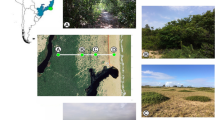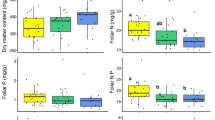Abstract
Comprehensive information on geographic patterns of leaf morphological traits in Chinese forests is still scarce. To explore the spatial patterns of leaf traits, we investigated leaf area (LA), leaf thickness (LT), specific leaf area (SLA), and leaf dry matter content (LDMC) across 847 species from nine typical forests along the North-South Transect of Eastern China (NSTEC) between July and August 2013, and also calculated the community weighted means (CWM) of leaf traits by determining the relative dominance of each species. Our results showed that, for all species, the means (± SE) of LA, LT, SLA, and LDMC were 2860.01 ± 135.37 mm2, 0.17 ± 0.003 mm, 20.15 ± 0.43 m2 kg–1, and 316.73 ± 3.81 mg g–1, respectively. Furthermore, latitudinal variation in leaf traits differed at the species and community levels. Generally, at the species level, SLA increased and LDMC decreased as latitude increased, whereas no clear latitudinal trends among LA or LT were found, which could be the result of shifts in plant functional types. When scaling up to the community level, more significant spatial patterns of leaf traits were observed (R 2 = 0.46–0.71), driven by climate and soil N content. These results provided synthetic data compilation and analyses to better parameterize complex ecological models in the future, and emphasized the importance of scaling-up when studying the biogeographic patterns of plant traits.
Similar content being viewed by others
References
Aho K, Derryberry D, Peterson T, 2014. Model selection for ecologists: The worldviews of AIC and BIC. Ecology, 95: 631–636.
Andersen K M, Endara M J, Turner B L et al., 2012. Trait-based community assembly of understory palms along a soil nutrient gradient in a lower montane tropical forest. Oecologia, 168: 519–531.
Chapin F S, Autumn K, Pugnaire F, 1993. Evolution of suites of traits in response to environmental-stress. American Naturalist, 142: S78–S92.
Chapin F S, Matson P A, Mooney H A, 2002. Principles of Terrestrial Ecosystem Ecology. New York: Springer, 123–155.
Cornelissen J H C, Lavorel S, Garnier E et al., 2003. A handbook of protocols for standardised and easy measurement of plant functional traits worldwide. Australian Journal of Botany, 51: 335–380.
Cornwell W K, Ackerly D D, 2009. Community assembly and shifts in plant trait distributions across an environmental gradient in coastal California. Ecological Monographs, 79: 109–126.
Domínguez M T, Aponte C, Perez-Ramos I M et al., 2012. Relationships between leaf morphological traits, nutrient concentrations and isotopic signatures for Mediterranean woody plant species and communities. Plant and Soil, 357: 407–424.
Freschet G T, Dias A T C, Ackerly D D et al., 2011. Global to community scale differences in the prevalence of convergent over divergent leaf trait distributions in plant assemblages. Global Ecology and Biogeography, 20: 755–765.
Garnier E, Cortez J, Billes G et al., 2004. Plant functional markers capture ecosystem properties during secondary succession. Ecology, 85: 2630–2637.
Garnier E, Navas M L, 2012. A trait-based approach to comparative functional plant ecology: Concepts, methods and applications for agroecology: A review. Agronomy for Sustainable Development, 32: 365–399.
He H L, Liu M, Xiao X M et al., 2014. Large-scale estimation and uncertainty analysis of gross primary production in Tibetan alpine grasslands. Journal of Geophysical Research-Biogeosciences, 119: 466–486.
Hodgson J G, Montserrat-Marti G, Charles M et al., 2011. Is leaf dry matter content a better predictor of soil fertility than specific leaf area? Annals of Botany, 108: 1337–1345.
Kazakou E, Violle C, Roumet C et al., 2014. Are trait-based species rankings consistent across data sets and spatial scales? Journal of Vegetation Science, 25: 235–247.
Klumpp K, Soussana J F, 2009. Using functional traits to predict grassland ecosystem change: A mathematical test of the response-and-effect trait approach. Global Change Biology, 15: 2921–2934.
Liu G F, Freschet G T, Pan X et al., 2010. Coordinated variation in leaf and root traits across multiple spatial scales in Chinese semi-arid and arid ecosystems. New Phytologist, 188: 543–553.
Moles A T, Perkins S E, Laffan S W et al., 2014. Which is a better predictor of plant traits: Temperature or precipitation? Journal of Vegetation Science, 25: 1167–1180.
Niinemets U, 2001. Global-scale climatic controls of leaf dry mass per area, density, and thickness in trees and shrubs. Ecology, 82: 453–469.
Onoda Y, Westoby M, Adler P B et al., 2011. Global patterns of leaf mechanical properties. Ecology Letters, 14: 301–312.
Ordonez J C, van Bodegom P M, Witte J P M et al., 2009. A global study of relationships between leaf traits, climate and soil measures of nutrient fertility. Global Ecology and Biogeography, 18: 137–149.
Ordonez J C, van Bodegom P M, Witte J P M et al., 2010. Leaf habit and woodiness regulate different leaf economy traits at a given nutrient supply. Ecology, 91: 3218–3228.
Poorter H, Niinemets U, Poorter L et al., 2009. Causes and consequences of variation in leaf mass per area (LMA): A meta-analysis. New Phytologist, 182: 565–588.
Reich P B, Wright I J, Lusk C H, 2007. Predicting leaf physiology from simple plant and climate attributes: A global GLOPNET analysis. Ecological Applications, 17: 1982–1988.
Vile D, Shipley B, Garnier E, 2006. Ecosystem productivity can be predicted from potential relative growth rate and species abundance. Ecology Letters, 9: 1061–1067.
Wang R L, Yu G R, He N P et al., 2015. Latitudinal variation of leaf stomatal traits from species to community level in forests: Linkage with ecosystem productivity. Scientific Reports, 5: 14454. doi: 10.1038/srep14454.
Wright I J, Reich P B, Westoby M et al., 2004. The worldwide leaf economics spectrum. Nature, 428: 821–827.
Yu G R, Wen X F, Sun X M et al., 2006. Overview of ChinaFLUX and evaluation of its eddy covariance measurement. Agricultural and Forest Meteorology, 137: 125–137.
Zhang X S, Yang D A, 1995. Allocation and study on global change transects in China. Quaternary Sciences, (1): 43–52. (in Chinese)
Author information
Authors and Affiliations
Corresponding authors
Additional information
Foundation: National Natural Science Foundation of China, No.31290221, No.31470506; Chinese Academy of Sciences Strategic Priority Research Program, No.XDA05050702; Program for Kezhen Distinguished Talents in Institute of Geographic Sciences and Natural Resources Research, CAS, No.2013RC102
Author: Wang Ruili (1988–), PhD, specialized in variation of plant functional traits.
Rights and permissions
About this article
Cite this article
Wang, R., Yu, G., He, N. et al. Latitudinal variation of leaf morphological traits from species to communities along a forest transect in eastern China. J. Geogr. Sci. 26, 15–26 (2016). https://doi.org/10.1007/s11442-016-1251-x
Received:
Accepted:
Published:
Issue Date:
DOI: https://doi.org/10.1007/s11442-016-1251-x




